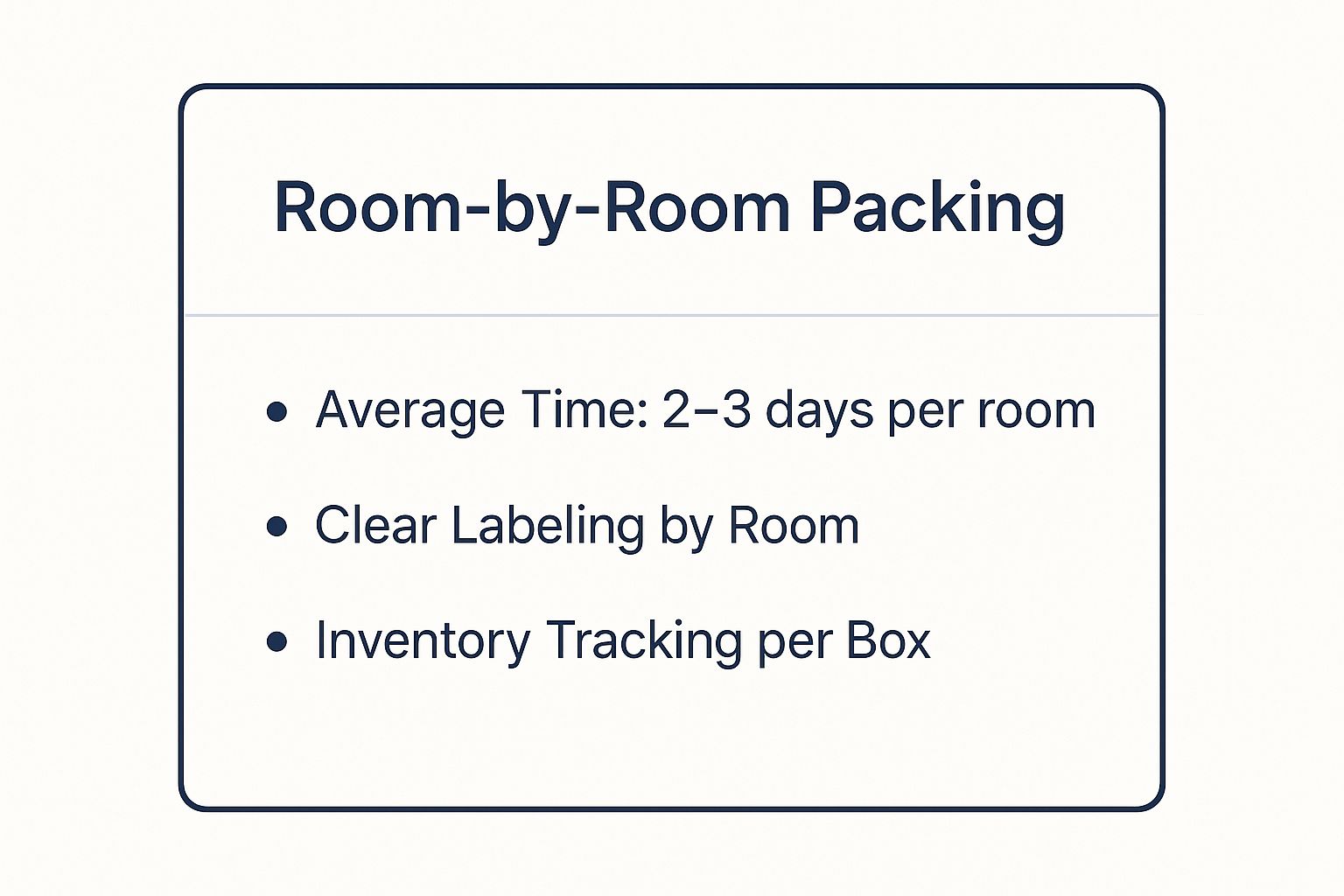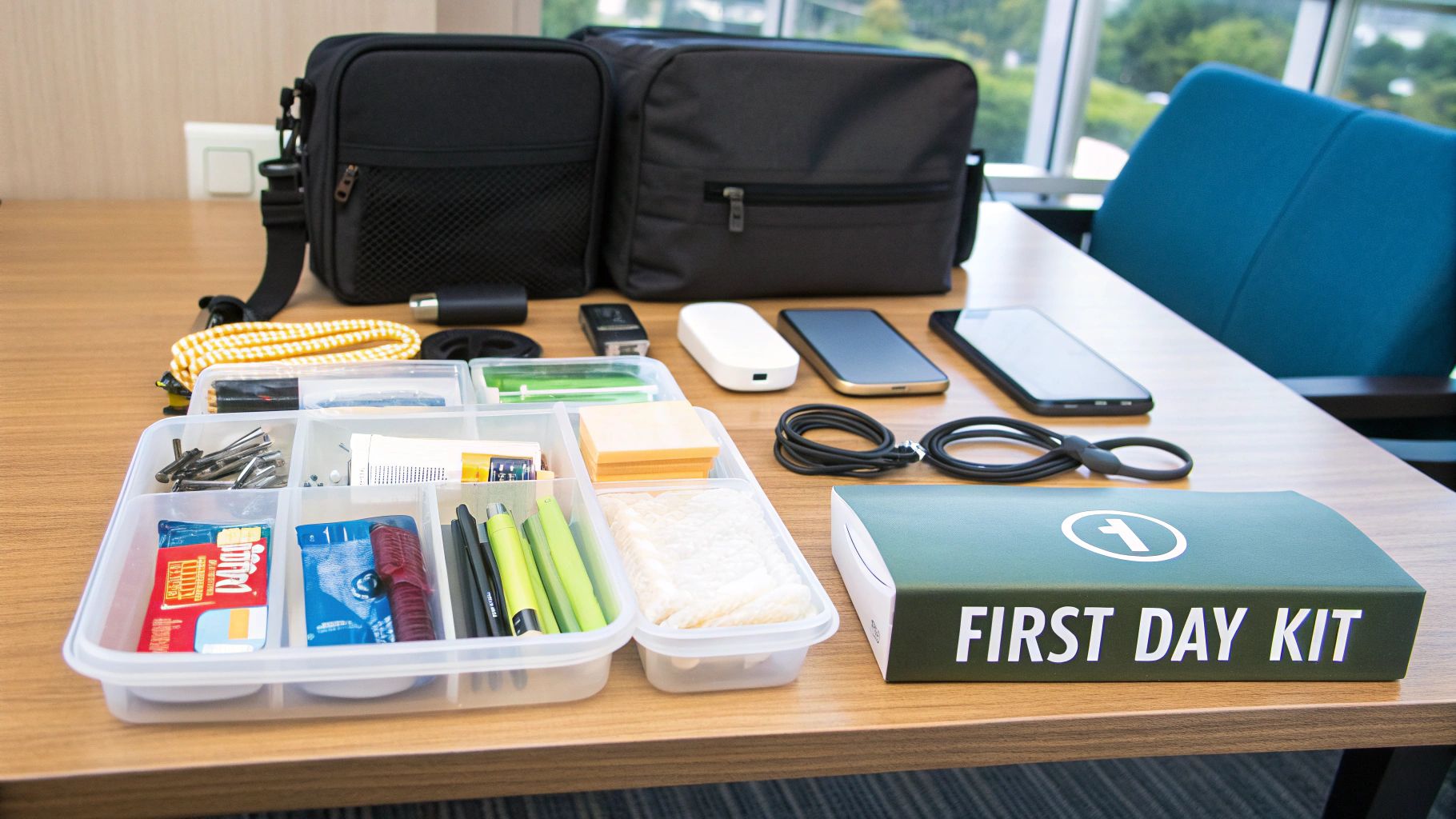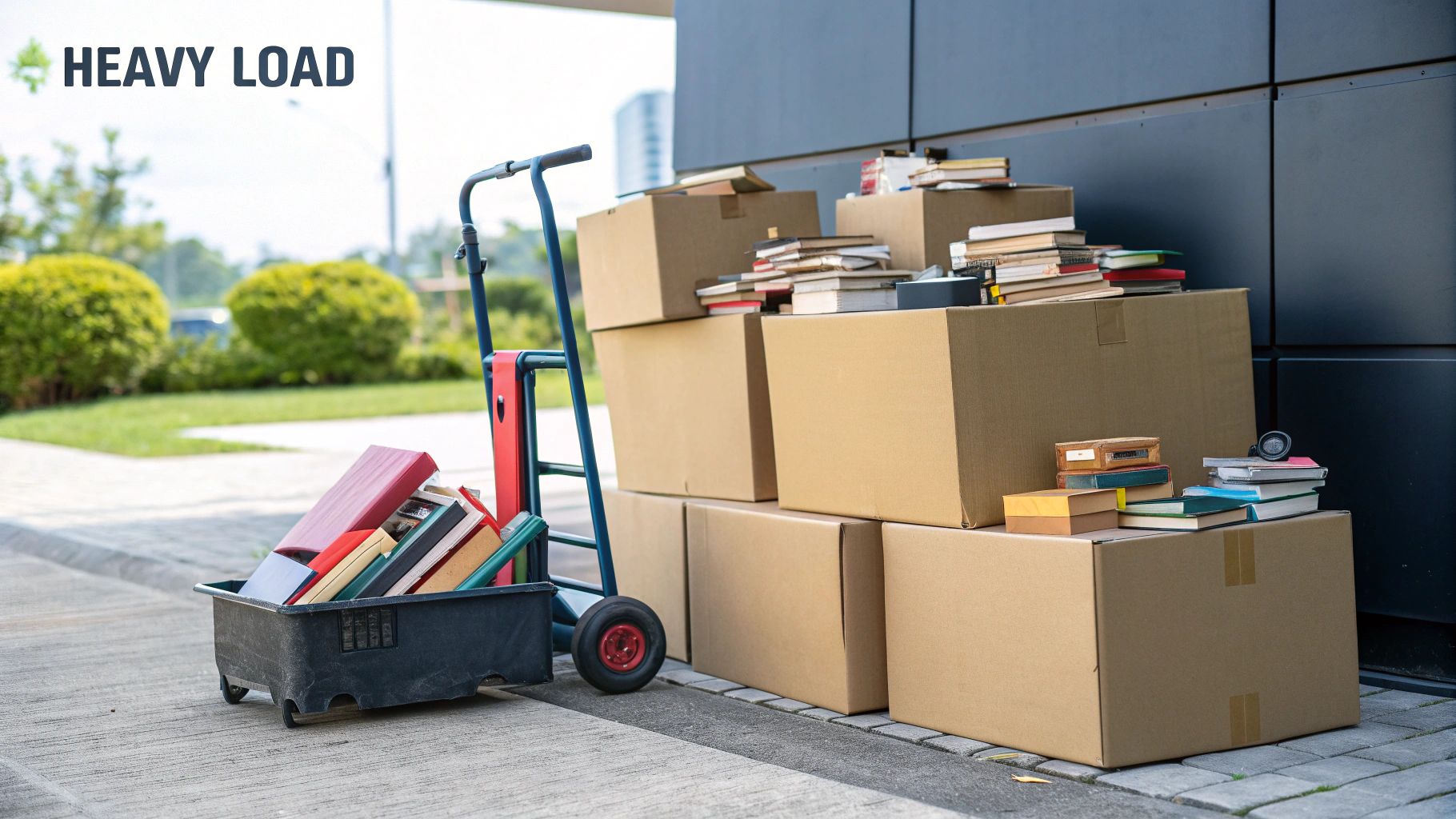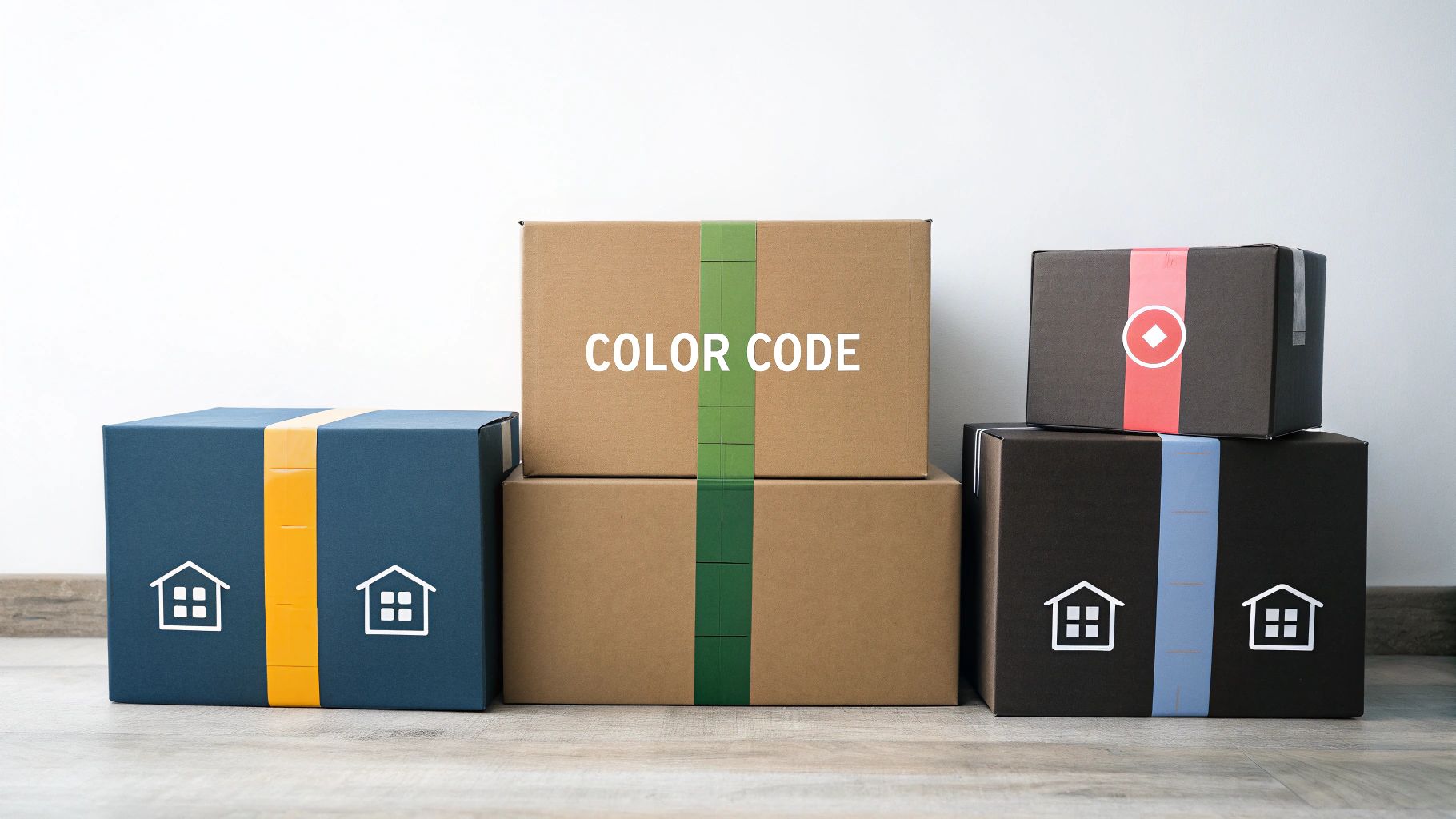Stress-Free Moving: Mastering the Art of Packing
Moving house can feel overwhelming. Packing efficiently, however, transforms the entire experience. This listicle provides seven actionable moving house packing tips to simplify your move, saving you time, effort, and stress. These practical hacks ensure a smooth transition to your new UK home.
These moving house packing tips cover everything from strategic box usage to clever labelling systems. Implementing these techniques will make unpacking in your new home significantly easier. You'll know precisely where everything is, avoiding the frustration of searching through endless boxes.
This guide breaks down the following essential moving house packing tips:
- Room-by-Room Packing
- Essential Box/First Day Survival Kit
- Heavy Items in Small Boxes
- Wardrobe Box Method
- Bubble Wrap and Newspaper Layering
- Color-Coded Labelling
- Detailed Inventory List
By mastering these straightforward moving house packing tips, you'll be well-equipped to handle your move with confidence and minimize the usual moving stress. Let's dive in!
1. Room-by-Room Packing Method
Moving house can feel overwhelming. One effective strategy to combat this is the room-by-room packing method. This systematic approach involves packing one room completely before starting on the next. Instead of scattering your packing efforts across the house, you concentrate on one space at a time, creating a more organised and less stressful experience. This methodical approach simplifies both packing and unpacking, streamlining the entire moving process.
Why Choose Room-by-Room?
This method offers several advantages. By focusing on a single room, you create a clear and manageable task. It also minimises the chance of misplacing items and reduces the sense of chaos often associated with moving. You'll know precisely where everything from that specific room is packed, simplifying unpacking in your new home. This structured approach also allows for more accurate inventory tracking and minimizes the likelihood of forgetting items.
Practical Examples
Professional moving companies, like United Van Lines, often recommend this method for its efficiency. Families moving cross-country have reported success using this strategy to stay organized during long-distance moves. It's equally effective for office relocations, allowing departments to pack systematically and minimizing disruption to workflow.
Implementing the Room-by-Room Method
Start with the least-used rooms, such as guest bedrooms or storage areas. This allows you to clear space and gain momentum before tackling more frequently used spaces. As you pack, use coloured tape or stickers to designate boxes for each room. Create a master inventory list for each room as well, detailing the contents of each box. This is invaluable during unpacking. Finally, pack a box of essentials for each room separately. This ensures you have immediate access to necessary items upon arrival at your new home.
The infographic below summarizes the key aspects of the room-by-room packing method for quick reference. It visualizes the average packing time, the importance of clear labeling, and the need for inventory tracking per box.

As the infographic illustrates, dedicating 2-3 days per room allows for thorough packing. Clear labeling by room and detailed inventory tracking for each box are crucial for an efficient unpacking process. These steps make the often daunting task of unpacking significantly less stressful.
Room-by-Room for a Smooth Move
By embracing the room-by-room packing method, you're choosing a structured, manageable approach to one of the most challenging aspects of moving house. This strategy minimizes stress, maximizes efficiency, and ensures a smoother transition to your new home. It's a valuable tool for anyone undertaking a house move, regardless of the size or distance. It’s a top tip for moving house packing efficiently and effectively.
2. Essential Box or 'First Day' Survival Kit
Moving house often means chaos, especially during the initial unpacking phase. An "Essential Box" or "First Day Survival Kit" combats this by providing immediate access to crucial items during the first 24-48 hours in your new home. This specially packed box contains everything you'll need, from toiletries and medications to a change of clothes and basic tools. It's packed last and unpacked first, providing a sense of order amid the moving mayhem.

Why Prepare a Survival Kit?
This kit eliminates the stress of rummaging through numerous boxes to find essential items upon arrival. It provides immediate access to necessities, allowing you to settle in comfortably before tackling the full unpacking process. This is especially crucial after a long moving day. Thinking ahead about these initial needs can significantly reduce stress and make the transition smoother.
Practical Examples
Moving blogger Jenny from 'The Moving Blog' documented saving 4 hours on move-in day thanks to her well-prepared survival kit. Real estate agents often recommend this tip to clients, highlighting its value in reducing moving stress. Military families, accustomed to frequent relocations, frequently utilize this technique for efficient settling-in.
Implementing the Survival Kit Strategy
Pack one survival kit per family member. Personalize each kit with individual toiletries, medications, and a change of clothes. Include cash for unexpected expenses, such as takeaway meals or last-minute supplies. A basic toolkit with a screwdriver, hammer, and measuring tape is invaluable for quick fixes and furniture assembly. Don't forget pet supplies and comfort items for children. Finally, keep important documents in a waterproof folder for easy access and safekeeping. If you’re concerned about the potential costs of your move in the UK, learn more about moving costs in the UK to better prepare yourself financially.
Survival Kit for a Smooth Start
Professional organizers like Marie Kondo and moving companies such as Two Men and a Truck champion the survival kit concept. By implementing this moving house packing tip, you're ensuring a more comfortable and less stressful start in your new home. It’s a simple yet effective strategy that can significantly improve your moving experience. This essential box provides a sense of normalcy amidst the upheaval, allowing you to focus on settling in rather than searching for essential items. It's a small investment of time that yields significant returns in peace of mind.
3. Heavy Items in Small Boxes Strategy
Moving house often involves packing numerous heavy items. The heavy items in small boxes strategy prioritizes safety and efficiency by packing dense items like books, canned goods, tools, and small appliances in smaller, more manageable boxes. This prevents overloading larger boxes, making them difficult and dangerous to lift, and reduces the risk of the box bottom giving way during the move. Aim for a maximum weight of 30-40 pounds per box.

Why Use Small Boxes for Heavy Items?
This method offers practical advantages for moving house packing tips. Overloaded boxes are a major cause of back injuries during moves. Distributing weight across multiple smaller boxes significantly reduces this risk. Smaller boxes are also easier to manoeuvre through doorways and up stairs. This is particularly helpful in UK homes, which often have narrow staircases and limited space.
Practical Examples
This strategy isn't new; it's a standard practice in several industries. Libraries use this method when relocating collections, ensuring the preservation of valuable books. Bookstores also employ this technique during inventory moves. Professional movers routinely use smaller boxes for tools and hardware, adhering to occupational safety guidelines and industry best practices.
Implementing the Heavy Items Strategy
Start by gathering sturdy, smaller boxes, ideally book boxes (around 1.5 cubic feet). Pack heavy items tightly, filling any remaining space with lighter items like linens or clothing. This maximizes space and prevents items from shifting during transit. Reinforce the bottoms of boxes with extra packing tape for added security. Always test lift boxes before sealing them completely to ensure they're manageable. Clearly label these boxes as "HEAVY" to alert movers and yourself. If you're considering self-storage during your move, learn more about what size storage unit you might need here.
Heavy Items Strategy for a Safe and Efficient Move
By adopting the heavy items in small boxes strategy, you're prioritizing safety and efficiency during your move. This method minimizes the risk of injury, protects your belongings, and contributes to a smoother, less stressful moving experience. It’s a crucial moving house packing tip for a successful relocation.
4. Wardrobe Box Method for Clothing
Moving house often means wrestling with piles of clothes and the inevitable wrinkles that follow. A game-changer in packing is the wardrobe box method. These specialized tall boxes, equipped with built-in hanging bars, allow clothes to remain on hangers throughout the moving process. This keeps clothing wrinkle-free, organized, and ready to hang immediately in your new wardrobes. This method is particularly valuable for suits, dresses, and other delicate garments susceptible to creasing.
Why Choose Wardrobe Boxes?
This method significantly reduces the time and effort involved in packing and unpacking clothes. Instead of folding, packing, and then ironing upon arrival, your clothes simply transfer from one wardrobe to another. This is a huge time saver, especially if you're moving a large volume of clothing. It also minimizes the risk of damage to delicate items, preserving their shape and quality. This organized approach makes unpacking a breeze, allowing you to quickly settle into your new home.
Practical Examples
Wardrobe boxes are a staple for professionals in various industries. Fashion retailers utilize them for store relocations, ensuring clothing arrives ready for display. Costume departments in theatres rely on these boxes for touring productions, keeping costumes pristine and organized. Luxury clothing boutiques employ them for inventory transfers, maintaining the quality and presentation of high-end garments. This demonstrates their effectiveness in preserving clothing during transit.
Implementing the Wardrobe Box Method
While beneficial, wardrobe boxes are best suited for specific clothing types. Use them primarily for work clothes, formal wear, and delicate items. For casual clothes, using sturdy garbage bags can be a more cost-effective option. Maximize the space within the wardrobe box by filling the bottom section with shoes, accessories, or folded sweaters. Group similar items together within the box to maintain organization. Renting wardrobe boxes from removal companies or storage facilities is a budget-friendly alternative to purchasing them outright.
Wardrobe Boxes for a Stress-Free Clothing Move
By using the wardrobe box method, you're choosing a smart, efficient way to manage the often tedious task of packing and unpacking clothes. This method saves time, minimizes wrinkles, and protects your most valued garments during the moving process. This is a valuable moving house packing tip for anyone looking to streamline their move and arrive at their new home with ready-to-wear clothing. It's especially beneficial for those moving long distances or with a substantial wardrobe. It's a top tip for moving house packing and keeping your clothes in pristine condition.
5. Bubble Wrap and Newspaper Layering Technique
Moving fragile items requires more than just placing them in a box. The bubble wrap and newspaper layering technique provides optimal protection by combining different cushioning materials. This method involves wrapping items individually in tissue paper or newspaper for initial protection, then adding a layer of bubble wrap for shock absorption. Finally, secure the wrapping with packing tape. Multiple items can then be nestled together in boxes with extra padding, ensuring they arrive safely at your new home.
Why Layer Protection?
This technique offers superior protection compared to using just one material. Newspaper acts as a soft, initial barrier against scratches and minor bumps, while the bubble wrap provides a crucial layer of cushioning against more significant impacts. Layering helps prevent direct contact between fragile items and the box, minimizing the risk of breakage during transit. This is particularly important for delicate items like glassware, ceramics, and electronics.
Practical Examples
This technique isn't just for household moves. Art galleries use this method to transport paintings safely. Antique dealers rely on it for shipping valuable pieces. Even electronics manufacturers employ this layering technique for product packaging. These examples demonstrate the effectiveness of layered protection for even the most delicate items.
Implementing the Layering Technique
- Wrap individually: Wrap each item individually, even if packing similar items together. This prevents them from rubbing against each other and causing damage.
- Newspaper first: Use newspaper for the initial wrap to provide a soft buffer. This also offers an eco-friendly way to reuse old newspapers.
- Bubble wrap shield: Apply a layer of bubble wrap over the newspaper, ensuring complete coverage. Secure the wrap with packing tape.
- Create nests: In the box, create "nests" of crumpled paper to cushion the wrapped items and prevent shifting during the move.
- Mark clearly: Label boxes containing fragile items with "FRAGILE" on multiple sides. This alerts movers to handle these boxes with extra care.
- Fill empty spaces: Fill all empty spaces in the box with additional packing material, such as crumpled paper or packing peanuts, to prevent items from moving around.
Layering for Peace of Mind
The bubble wrap and newspaper layering technique is more than just a moving house packing tip; it's an investment in the safety of your belongings. By taking the extra time to layer your fragile items, you significantly reduce the risk of damage during transit. This proactive approach offers peace of mind, knowing your cherished possessions are well-protected throughout the moving process. It’s a valuable method for anyone moving house, ensuring a smoother and less stressful transition.
6. Color-Coded Labeling System
Moving house often involves a mountain of boxes, making it easy to lose track of what goes where. A color-coded labeling system transforms this potential chaos into organized efficiency. This method uses colored tape, stickers, or markers to designate boxes by room, contents, or priority. Each designated area receives a specific color, making it instantly recognizable for movers and family members. This visual system drastically speeds up the sorting and placement process, ensuring a smoother, less stressful unpacking experience.

Why Use Color-Coding?
This system adds a crucial visual layer to your moving house packing tips. It goes beyond simple labeling, providing at-a-glance identification of box destinations. This is especially helpful when directing movers, as they can quickly and accurately place boxes in the correct rooms without needing to decipher handwriting or extensively consult inventory lists. This reduces confusion, speeds up the unloading process, and ultimately lowers moving costs. Learn more about color-coded labeling systems and other organizational methods at Euro Move Direct Indoor Storage.
Practical Examples
Professional moving companies like PODS often recommend color-coding to their customers, highlighting its effectiveness in streamlining the moving process. Large institutions, such as school districts during classroom relocations, utilize this method to manage the logistics of moving numerous items efficiently. Even hospitals employ color-coding for department moves, ensuring sensitive equipment reaches its correct destination quickly and safely. This method clearly demonstrates its value across diverse moving scenarios.
Implementing a Color-Coded System
- Create a legend: Develop a clear color key matching colors to rooms or content categories. Post this prominently during packing and unpacking.
- Choose bright colors: Use contrasting colors to ensure easy visibility and avoid confusion.
- Multiple sides: Apply colored tape or stickers to multiple sides of each box, ensuring visibility from any angle.
- Photographic record: Take photos of your color system as a backup reference, especially helpful if the legend gets misplaced.
- Backup labels: Have backup written labels in case tape falls off or becomes obscured.
Color-Coding for a Streamlined Move
By incorporating a color-coded labeling system into your moving house packing tips, you’re choosing a visual, efficient method to manage the logistics of your move. This simple yet powerful strategy significantly reduces unpacking time, minimizes confusion, and streamlines the entire moving process, from packing to placement. This is one of the best tips for an organized and stress-free move.
7. Inventory List Documentation
Moving house involves a multitude of tasks, and keeping track of your belongings can quickly become overwhelming. Inventory list documentation provides a systematic approach to managing your possessions during a move. This comprehensive tracking system records every packed item, its corresponding box number, contents, and destination room. Implementing this method, whether on paper, a spreadsheet, or using specialized moving apps, transforms a potentially chaotic process into an organized and manageable one. It provides peace of mind knowing exactly where everything is packed.
Why Choose Inventory List Documentation?
This method offers significant advantages beyond simply knowing what's in each box. Detailed inventory lists are invaluable for insurance purposes in case of loss or damage. They also simplify the unpacking process, allowing you to prioritize boxes and quickly locate specific items. This structured approach saves time and reduces stress, making the entire move more efficient. A well-maintained inventory serves as a master record of your belongings, useful even after settling into your new home.
Practical Examples
The importance of inventory documentation is recognized across various moving scenarios. Corporate relocations often mandate inventory tracking to ensure all company assets are accounted for. International moves necessitate detailed inventories for customs purposes and to facilitate the smooth transition of belongings across borders. Insurance companies also frequently request inventories when processing claims for lost or damaged items during a move.
Implementing Inventory List Documentation
There are several ways to create an effective inventory system. Smartphone apps like 'Moving Day' or 'Sortly' offer convenient digital solutions for tracking your items, often including features like photo documentation and cloud storage. If you prefer a more traditional approach, number your boxes sequentially with a permanent marker and maintain a detailed written or spreadsheet record of their contents. Including photos of valuable items adds an extra layer of security. Keep one copy of the inventory with you during the move and store another in a secure location. Remember to update the list if you repack or add items after the initial packing. Learn more about inventory documentation and security.
Inventory Documentation for a Stress-Free Move
By adopting inventory list documentation, you're choosing organization over chaos. This method empowers you to manage your possessions effectively during a move, minimizing stress and maximizing efficiency. It’s a valuable tool for anyone undertaking a house move, offering peace of mind and ensuring a smoother transition to your new home. It's a moving house packing tip that truly elevates your entire moving experience, particularly for valuable or irreplaceable items. This meticulous approach streamlines unpacking and provides essential documentation for insurance purposes. Moving house packing tips often overlook this crucial aspect, but taking the time to document your belongings is a smart investment in a stress-free move.
7 Essential Moving Packing Tips Comparison
| Method / Feature | Implementation Complexity 🔄 | Resource Requirements ⚡ | Expected Outcomes 📊 | Ideal Use Cases 💡 | Key Advantages ⭐ |
|---|---|---|---|---|---|
| Room-by-Room Packing Method | Low 🔄 Beginner-friendly | Moderate ⚡ Requires many boxes initially | Organized packing, easier unpacking 📊 | Larger homes, multi-room moves, offices | Clear progress tracking, simplified unpacking ⭐ |
| Essential Box or 'First Day' Kit | Low to Moderate 🔄 Requires planning | Low to Moderate ⚡ Small dedicated boxes | Immediate access to essentials 📊 | New home arrival, first 24-48 hours | Reduces stress, eliminates frantic searching ⭐ |
| Heavy Items in Small Boxes | Moderate 🔄 Requires box selection | Moderate to High ⚡ Needs many small boxes | Safe lifting, prevent box damage 📊 | Packing heavy items: books, tools, canned goods | Injury prevention, box durability ⭐ |
| Wardrobe Box Method for Clothing | Moderate 🔄 Specialized boxes needed | Moderate to High ⚡ Rental or purchase cost | Wrinkle-free clothes, quick unpack 📊 | Formal wear, delicate garments, fashion items | Saves time, protects delicate clothing ⭐ |
| Bubble Wrap and Newspaper Layering Technique | High 🔄 Time-consuming wrapping | Moderate to High ⚡ Various packing materials | Superior fragile item protection 📊 | Fragile valuables: art, antiques, electronics | Excellent protection, versatile ⭐ |
| Color-Coded Labeling System | Low 🔄 Requires setup and consistency | Low ⚡ Colored tapes/stickers | Faster sorting and placement 📊 | Any size move, multi-room or family moves | Speeds logistics, reduces confusion ⭐ |
| Inventory List Documentation | High 🔄 Time-intensive and detailed | Low to Moderate ⚡ Requires tracking tools | Quick item location, insurance ready 📊 | Large moves, international relocations | Insurance proof, item tracking ⭐ |
Packing Perfection: Your New Home Awaits!
Moving house can feel like a monumental task. However, armed with the right moving house packing tips, you can conquer the chaos and transform the experience into a well-orchestrated move. This article has explored seven key strategies to simplify your packing process, from the room-by-room method to the color-coded labeling system. By implementing these tips, you'll not only save time and energy but also reduce the stress often associated with relocating.
Key Takeaways for a Smooth Move
Let's recap the most impactful takeaways: Packing strategically, not just quickly, is paramount. Remember the power of the 'First Day' survival kit, ensuring essential items are readily available upon arrival. Maximizing space by placing heavy items in small boxes and using wardrobe boxes for clothing prevents damage and streamlines unpacking. The bubble wrap and newspaper layering technique provides extra protection for fragile items. Finally, the color-coded labeling system and detailed inventory list make unpacking a breeze, saving you valuable time and effort in your new home.
Putting it All Together: Your Action Plan
Now that you're equipped with these moving house packing tips, it's time to put them into action. Start by assessing your belongings and gathering packing supplies. Create your inventory list as you pack each box. Remember, a well-planned packing process sets the stage for a smooth transition into your new home. Embrace these strategies, and you'll be unpacking and settling in before you know it.
From Packing to Paradise: Enjoy Your New Home
Moving signifies new beginnings, fresh starts, and the excitement of creating a new space to call your own. By mastering these packing techniques, you'll eliminate unnecessary stress and free yourself to focus on the joy of settling into your new surroundings. Visualize yourself effortlessly unpacking, each box revealing its contents with ease, thanks to your meticulous preparation.
Ready to make your move even smoother? Euro Move Direct offers comprehensive moving services, from local to international relocations, taking the hassle out of your moving experience. Their expertise complements the packing tips outlined in this article, ensuring a seamless transition to your new home. Visit Euro Move Direct to learn more and request a quote today.